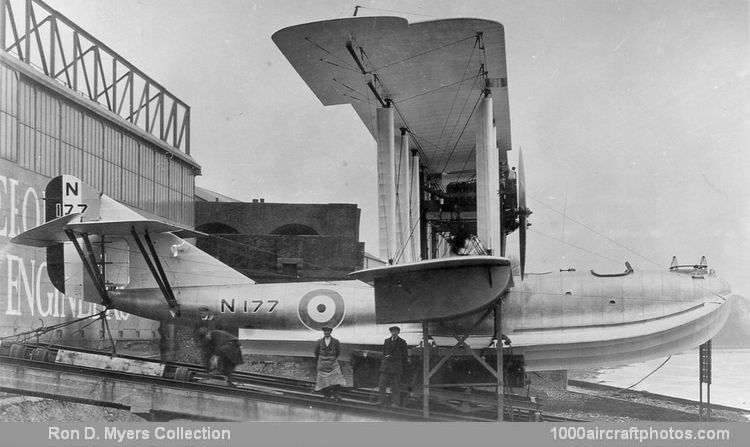08/31/2014. Remarks by Johan Visschedijk: "Intended as an improvement upon the Felixstowe F.3, the F.5 appeared in early 1918. Externally similar to its predecessors, and employing the standard Porte hull construction, it embodied a number of refinements developed as a result of experience with the previous designs. The top decking of the hull was deeper than before, and the pilots were seated in an open cockpit, while the gun positions were of the same arrangement as the F.3.
Four 230 pound bombs could be carried in the standard underwing racks. The wing structure was entirely new, with a span greater than the F.3 and a modified section, also constant chord ailerons. A broad-chord tail plane projected ahead of the fin leading edge, the rudder, and the ailerons, being horn-balanced. Serialed N90, the prototype was powered by two 350 hp Rolls-Royce Eagle VIIs driving four-bladed tractor propellers, and on its official trials it displayed a much better performance than the F.3, even under conditions of overload.
Unfortunately, the prototype F.5 fell foul of economics, for the large F.3 construction program did not readily permit the introduction of a new type. A compromise was reached with the extensive modification of the F.5 to incorporate as many F.3 components as possible, resulting in a machine not wholly satisfactory, but nevertheless put into production. The hull of the modified machine was similar to that of N90, but its overall covering of plywood, with only the top decking of fabric, added considerably to the weight, which, in the completed aircraft, exceeded that of N90 by more than 1,000 lb (454 kg). The wing structure was that of the F.3, modified to take constant chord ailerons, and the tail unit was identical to that of the prototype, although later F.5s had horn-balanced elevators. The slightly greater wing span of the F.5 as compared to the F.3 was accounted for by the ailerons, which extended beyond the wing tips.
Official test figures show that the performance of the production F.5 was inferior to that of the F.3, and in some instances this was further impaired by the fitting of lower powered engines, the 325 hp Rolls-Royce Eagle VII.
Too late for operational service, the type was adopted as the RAF's standard post-war flying boat and remained in service until replacement by Southamptons in 1925. In the summer of 1919, an early production F.5, N4044, toured Scandinavia to demonstrate the capabilities of flying boats, covering 2,450 mls (3,943 km) in 27 days and returning to Felixstowe fully serviceable. Another equally successful tour took p1ace in 1923, when two F.5s commanded by Air Commodore Bigsworth completed a cruise to Gibraltar, Malta, Bizerta (Tunesia), and Oran (Algeria) without mishap.
Before the Armistice, F.5 production had started in Canada at the factory of Canadian Aeroplanes Ltd. to the order of the United States Air Board. These machines were fitted with the Liberty 12 engine of 400 hp and equipped the US NAS in 1918. A series of structurally modified F.5s was also built by the US Naval Aircraft Factory at Philadelphia; these too had the Liberty engine and were designated F.5L. The F.5L could carry 1,000 lb (454 kg) of bombs and up to eleven machine guns, and some mounted a Davis quick-firing gun in the bows. These machines gave years of service to the USN, both in the Atlantic and the Pacific Fleets, later versions having a greatly enlarged fin and a horn-balanced rudder. Also in America, two converted F.5Ls formed the equipment of one of the first airlines to operate flying boats, Aeromarine West Indies Airways, Inc., in 1920.
In 1921, the Japanese company, Aichi of Nagoya, obtained a license to build F.5s and produced fifteen machines which served with the Imperial Japanese NAS and made several notable long-distance flights, recording durations of over nine hours in some cases. In the UK, the F.5 was used for a number of experiments, among which were the trial of auxiliary airfoil aileron balances on N4838, the fitting by Saunders of a special hollow-bottom hull to N178, and the first military flying boat in the world to be fitted with an all-metal hull by Short Brothers, the above pictured N177, produced in 1924. The F.5 formed the equipment of eight RAF squadrons, a ninth, No. 230, being renumbered No. 480 Flight at the end of 1922 and forming the training establishment for flying boats at Calshot."
